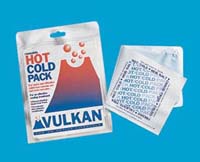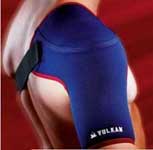Rotator Cuff Injury & Football
May 13 2008 | Articles

Rotator Cuff (shoulder) Injury Explained
Shoulder pain normally results from an injury to the rotator cuff. This injury initially manifests itself as an inflammation, a condition medically termed as Rotator Cuff Tendonitis. Surrounding the shoulder joint are the four muscles that make up the rotator cuff: Subscapularis, Supraspinatus, Infraspinatus and Teres minor. These muscles have individual functions however; their primary function is to provide stability to the humeral head, the ball in the shoulder socket.
It is highly uncommon for the Rotator Cuff to be damaged in a single traumatic situation. Instead, the injury begins with a minimal but continuous source of pain, something referred to as a micro trauma. This micro trauma will cause the rotator cuff to swell. Partial tears will develop in the cuff if the inflammation is allowed to pursue over time. Eventually, these partial tears will develop into complete tears, a kind of damage where there is an actual rip in one or more of the actual cuff muscles.
There are three main causes of micro trauma to the rotator cuff:
1. Primary Impingement
2. Secondary Impingement
3. Overstraining
Rotator Cuff Injury Signs & Symptoms
Rotator cuff injury will result in a restriction in the shoulder’s range of movement. The player will also complain of weakness and depending on the severity of injury, there will be varying degrees of pain. A player with a tear in the rotator cuff may experience enough pain to keep him from sleeping while a patient with early-stage inflammation may only experience soreness when performing overhead activities.
The existence, as well as the severity, of the Rotator Cuff Injury can be easily determined through various physical tests administered by a physiotherapist.
The physiotherapist may also look out for indications of instability within the shoulder joint. In order to assess the severity of the condition and to determine if the injury has resulted in a tear in the rotator cuff, MRI scans will be required. X-rays can also give indications of the presence of any bony injury.
Rotator Cuff Injury Treatment
What you can do
Surgery is the best method of addressing the tears in the rotator cuff. If the injury does not result in a tear, physiotherapy should reduce inflammation as well as the degeneration of the cuff.
This can be accomplished through ice therapy, provided that extra care is given to make sure that the ice does not directly touch the skin since this may cause ice burns. Anti-inflammatory gels and tablets may also be of help. If the player intends to continue with his physical activities, the use of a neoprene shoulder support may be helpful in providing him with sufficient support and stability.
Reusable ice packs can be used to help alleviate the pain as well as reduce bleeding within the tissue

View Reusable ice pack
Some doctors support the use of injections. However, do not inject the corticosteroid directly into the shoulder to reduce inflammation.
Exercise may begin shortly after the inflammation and the pain have subsided. A carefully-monitored regimen of strengthening and stabilising activities may also follow. Patients may use resistance bands to improve their workout. More importantly, the patient must develop activities that will correct faulty techniques that may have caused the injury.
If physiotherapy is unable to improve the rotator cuff’s condition, an operation must be performed in order to address the inflammation as well as the deterioration of the cuff.
Rotator Cuff Injury Prevention
What you can do
Athletes must not neglect the shoulder muscles. They must always maintain flexibility, strength and endurance in the shoulder muscles.
In order to avoid overloading the rotator, the athlete must make sure that changes in his activity are carried out gradually. Athletes may also opt to use resistance bands in order to improve their shoulder strength.
Finally, injury may be prevented if the person engages in adequate warm up and cool down routines.
Football Rescue Recommends
![]()
![]()
![]()
![]()
![]() 5 Star Rating
5 Star Rating

This high quality neoprene shoulder strap helps reduce shoulder pain, reduce swelling and accelerate healing. Custom fits the shoulder itself.
How does it work?
The Vulkan Neoprene range features premium quality neoprene. This offers support, compression, heat retention and comfort. Vulkan Neoprene has a unique spiral lining for removing excess perspiration, which avoids skin problems and is more comfortable to wear.
Retaining heat and providing support is helpful for the treatment and prevention of shoulder pain. By increasing local blood flow, healing and recovery times can be reduced following a shoulder injury. The Vulkan Shoulder Strap applies uniform compression around the ‘ball’ of the shoulder (Deltoid and Rotator cuff region). Women often find that the Vulkan Shoulder Strap is very comfortable to wear as the strap does not cut across the breast region.
It can be used anytime for therapeutic heat and pain relief for shoulder bursitis, rotator cuff injury or impingement syndrome.
It is ideal for sports, where a restriction of shoulder movements is not desirable.
Unrestricted arm movement.
View shoulder supports that provides support for the entire shoulder joint.
